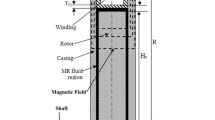Abstract
Owing to their quick response as compared to conventional hydraulic brakes, magnetorheological brakes (MR brakes) are being investigated for a variety of applications. MR brakes usually operate in a shear mode, and thus, lower braking torque is observed to be limiting factor for their adoption for applications like road vehicles. This work presents experimental investigations on shear and squeeze mode MR brake which may potentially offer higher torque as compared to shear mode MR brake. Design of the brakes including the squeeze mechanism is presented which is followed by analytical estimation of output torque for both types of brakes. Experimental investigations in terms of braking torque for various levels of influencing parameters, viz. input current and speed and temperature rise during brake actuation, are carried out with the help of specially designed experimental setup. The analytical and experimental results for both types of MR brakes are compared and discussed. Correlation analysis is made using MINITAB to ascertain the effect of influencing parameters on brake torque output. Though the marginal rise in torque output is observed with squeeze mode MR brake, further design efforts are essential for exploring and realizing squeeze mode MR brake applications.



















Similar content being viewed by others
References
Park EJ, Stoikov D, da Luz LF, Suleman A (2006) A performance evaluation of an automotive magnetorheological brake design with a sliding mode controller. Mechatronics 16(7):405–416
Olabi AG, Grunwald A (2007) Design and application of magneto-rheological fluid. Mater Des 28(10):2658–2664
Karakoc K, Park EJ, Suleman A (2008) Design considerations for an automotive magnetorheological brake. Mechatronics 18(8):434–447
Huang J, Zhang JQ, Yang Y, Wei YQ (2002) Analysis and design of a cylindrical magneto-rheological fluid brake. J Mater Process Technol 129(1–3):559–562
Li WH, Du H (2003) Design and experimental evaluation of a magnetorheological brake. Int J Adv Manuf Technol 21(7):508–515
Park EJ, da Luz LF, Suleman A (2008) Multidisciplinary design optimization of an automotive magnetorheological brake design. Comput Struct 86(3–5):207–216
Younis A, Karakoc K, Dong Z, Park E, Suleman A (2011) Application of SEUMRE global optimization algorithm in automotive magnetorheological brake design. Struct Multidiscip Optim 44(6):761–772
Assadsangabi B, Daneshmand F, Vahdati N, Eghtesad M, Bazargan-Lari Y (2011) Optimization and design of disk-type MR brakes. Int J Automot Technol 12(6):921–932
Sukhwani VK, Hirani H (2008) Design, development, and performance evaluation of high-speed magnetorheological brakes. Proc Inst Mech Eng Part L J Mater Des Appl 222(1):73–82
Nguyen QH, Choi SB (2010) Optimal design of an automotive magnetorheological brake considering geometric dimensions and zero-field friction heat. Smart Mater Struct 19(11):115024
Nguyen PB, Choi SB (2011) A new approach to magnetic circuit analysis and its application to the optimal design of a bi-directional magnetorheological brake. Smart Mater Struct 20(12):125003
Nguyen QH, Choi SB (2012) Optimal design of a novel hybrid MR brake for motorcycles considering axial and radial magnetic flux. Smart Mater Struct 21(5):055003
Marannano G, Virzi’Mariotti G, Duboka C (2011) Preliminary design of a magnetorheological brake for automotive use. In: Science and motor vehicles 2011, RS
Sarkar C, Hirani H (2015) Finite element analysis of magnetorheological brake using ANSYS. Int J Curr Eng Technol 5:725–732
Patil SR, Powar KP, Sawant SM (2016) Thermal analysis of magnetorheological brake for automotive application. Appl Therm Eng 98:238–245
Patil SR, Sawant SM (2014) Reliability analysis of automotive magnetorheological brake: a qualitative approach. In: ASME 2014 12th biennial conference on engineering systems design and analysis. American Society of Mechanical Engineers, pp V003T10A003–V003T10A003
Abdullah MA, Zainordin AZ, Hudha K (2015) Performance evaluation of shaft speed control using a magnetorheological brake. Int J Automot Mech Eng 11:2654
Patil SR, Sawant SM (2018) Experimental studies on magnetorheological brake for automotive application. Int J Automot Mech Eng 15(1):4893–4908
Sarkar C, Hirani H (2013) Theoretical and experimental studies on a magnetorheological brake operating under compression plus shear mode. Smart Mater Struct 22(11):115032
Sarkar C, Hirani H (2013) Design of a squeeze film magnetorheological brake considering compression enhanced shear yield stress of magnetorheological fluid. J Phys Conf Ser 412(1):012045
http://www.lord.com/products-and-solutions/magneto-rheological-%28mr%29.xml. Visited 4 Apr 2016
Tao R (2001) Super-strong magnetorheological fluids. J Phys Condens Matter 13(50):R979
Acknowledgements
The authors acknowledge the Rajarambapu Institute of Technology, Rajaramnagar, for the research grant released for this study.
Author information
Authors and Affiliations
Corresponding author
Additional information
Technical Editor: Pedro Manuel Calas Lopes Pacheco, D.Sc.
Rights and permissions
About this article
Cite this article
Patil, S.R., Lohar, R.A. Experimental investigations and characterization of shear and squeeze mode magnetorheological brake. J Braz. Soc. Mech. Sci. Eng. 40, 546 (2018). https://doi.org/10.1007/s40430-018-1457-1
Received:
Accepted:
Published:
DOI: https://doi.org/10.1007/s40430-018-1457-1




